More than 46 million homes in the U.S. have a cat. For many, cats are beloved companions, offering affection and joy. However, for individuals with allergies, the prospect of sharing a home with a feline can be daunting. Cat allergies are a common issue, but the good news is that you don’t necessarily have to forgo cat companionship. While no cat is entirely allergen-free, certain breeds, often referred to as “hypoallergenic cats,” produce fewer allergens, making them potentially suitable for allergy sufferers.
Understanding Hypoallergenic Cats
It’s crucial to understand that the term “hypoallergenic cat” is somewhat misleading. All cats produce allergens, primarily the Fel d 1 protein found in their fur, saliva, and urine. These proteins are the culprits behind allergic reactions. However, some cat breeds naturally produce lower levels of these proteins or have coat types that trap allergens more effectively, leading to fewer airborne allergens. Therefore, while a completely hypoallergenic cat doesn’t exist, certain breeds are less likely to trigger allergies and can be considered better options for people prone to sneezing and itching around cats.
Discover 12 Hypoallergenic Cat Breeds
If you’re seeking a feline companion but worry about allergies, exploring hypoallergenic cat breeds is a great starting point. Before welcoming any cat into your home, especially one labeled as “hypoallergenic,” spending time with the breed is essential. This direct interaction will help you gauge your allergic reaction and ensure a comfortable living situation for both you and your new pet.
Here are 12 cat breeds often recommended for allergy sufferers:
1. Siberian Cat
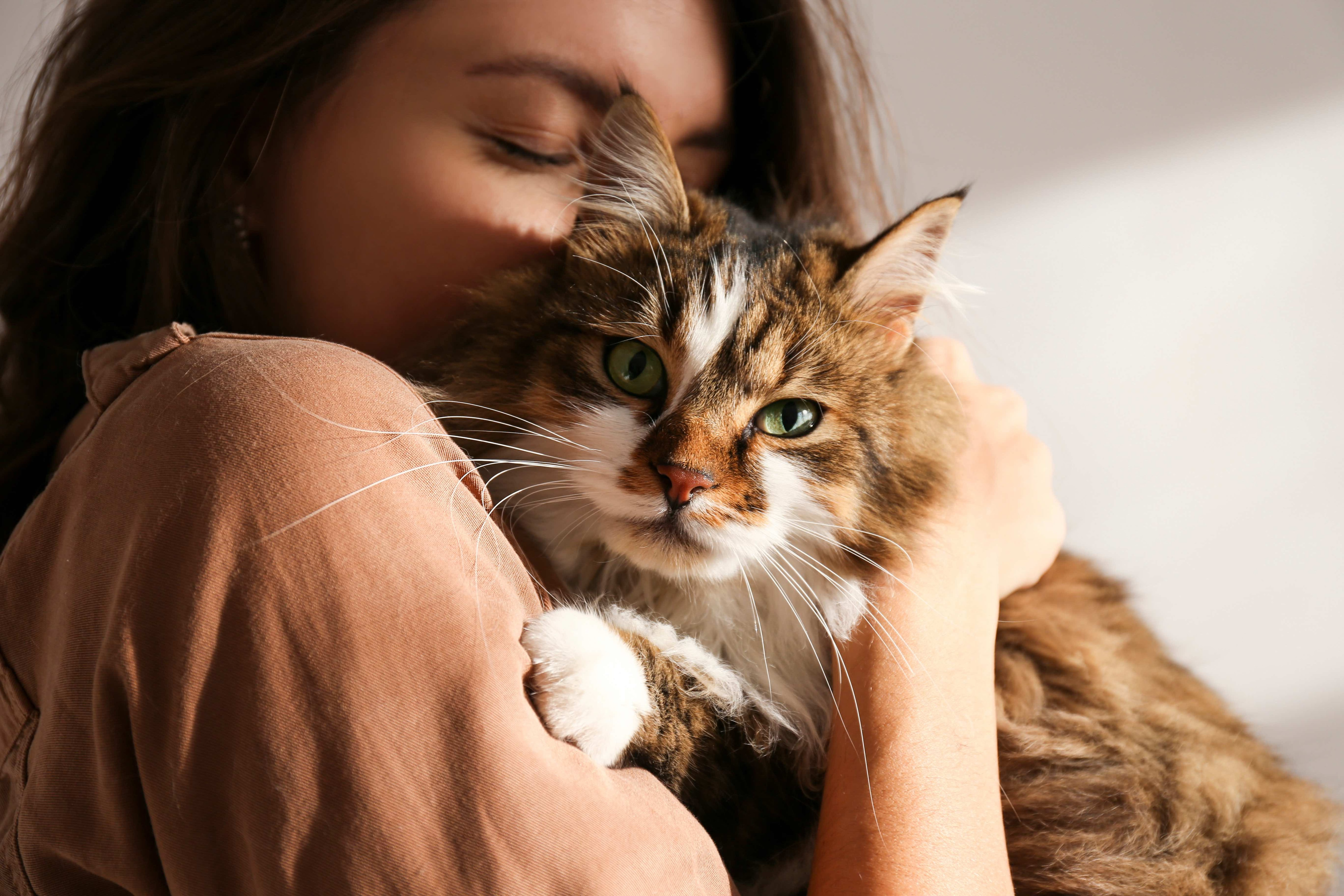 Woman lovingly snuggles a brown and white long-haired Siberian cat
Woman lovingly snuggles a brown and white long-haired Siberian cat
Photo credit: Adobe Stock/Evrymmnt
Siberian cats are a popular choice for those seeking a hypoallergenic feline friend. Despite their luxurious, thick, long coat, Siberians produce less of the Fel d 1 protein, the primary allergen, compared to many other cat breeds. This reduced allergen production makes them a potentially good fit for allergy-sensitive individuals. Beyond their hypoallergenic qualities, Siberians are known for their friendly and affectionate nature. They are wonderful family pets, adapting well to households with children and other animals. However, their magnificent coat requires regular grooming to prevent mats and tangles. If you can commit to brushing sessions, a Siberian cat can bring both beauty and companionship to your home without excessive allergy symptoms.
2. Siamese Cat
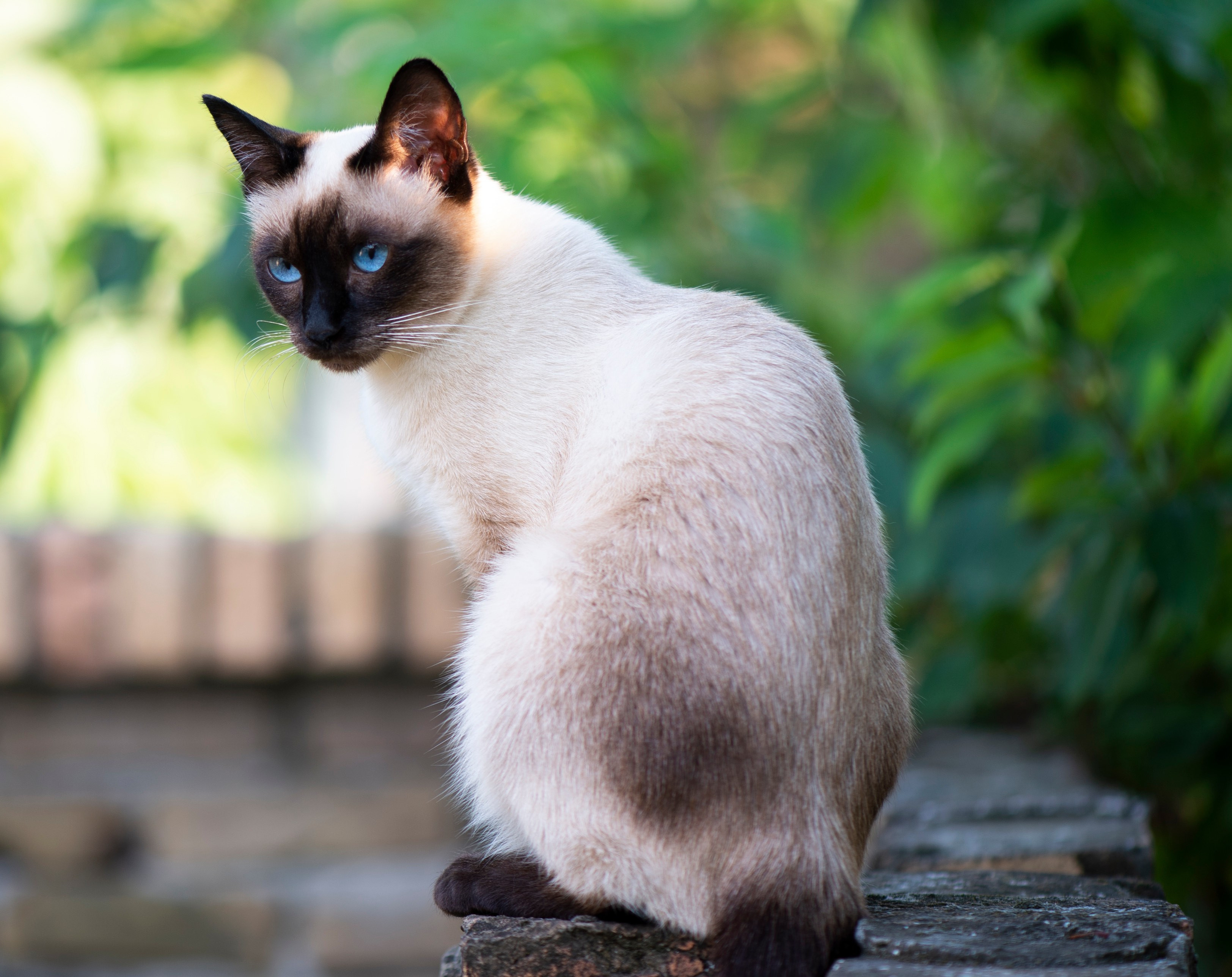 Elegant Siamese cat with blue eyes sits gracefully outdoors
Elegant Siamese cat with blue eyes sits gracefully outdoors
Photo credit: Adobe Stock/Vesna
The striking Siamese cat is another breed often listed among hypoallergenic cats. While no cat is truly non-shedding, Siamese cats possess a short, fine coat that sheds minimally. This reduced shedding translates to fewer allergens dispersed into the environment. Siamese cats are celebrated for their captivating blue almond-shaped eyes and their vocal personalities. They are known to be highly communicative, often “talking” to their owners. These intelligent and social cats form strong bonds with their families and crave attention. However, their demanding nature means they may not be ideal for households that are frequently empty. To keep your Siamese cat in optimal health, consider discussing Siamese cat-specific food options with your veterinarian to ensure they receive the nutrition they need.
3. Bengal Cat
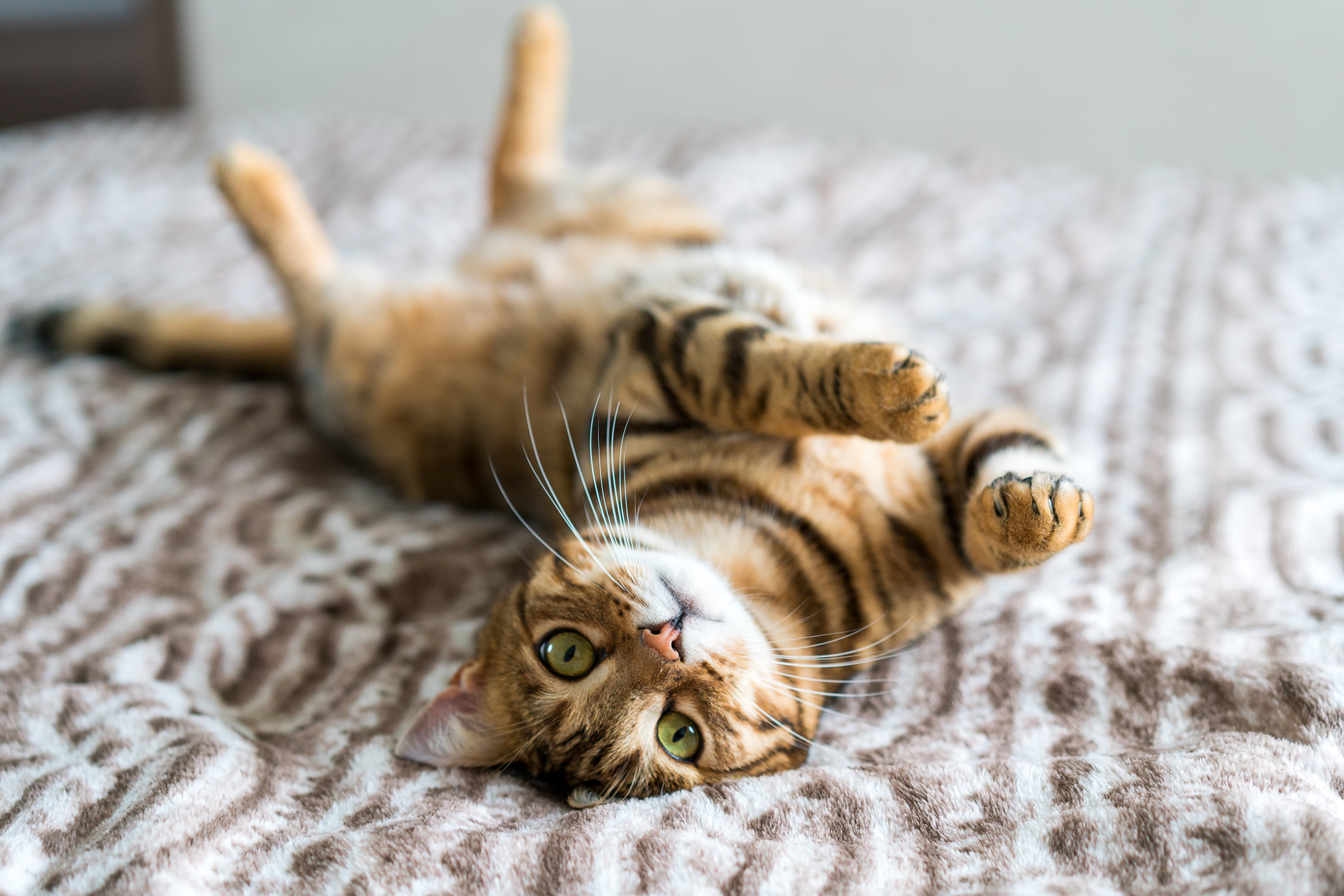 Bengal cat playfully lies on its back, exposing its spotted belly
Bengal cat playfully lies on its back, exposing its spotted belly
Photo credit: Adobe Stock/ingusk
Bengal cats are a visually striking and unique hypoallergenic breed. Their short, luxurious coat, adorned with distinctive spots or marbling, is inherited from their Asian leopard cat ancestry, giving them an exotic, wild cat appearance. Like other cats considered hypoallergenic, Bengals are low-shedding, which helps minimize the dispersal of allergens in the home. Beyond their looks, Bengal cats are known for their high energy levels and intelligence. They are active and playful cats who require plenty of mental and physical stimulation. Prospective Bengal owners should be aware that these intelligent felines can be demanding and may not be suitable for novice cat owners. Furthermore, some regions have specific regulations or even bans on Bengal ownership due to their wild heritage. For optimal health, consider discussing breed-specific cat food with your veterinarian to cater to their specific dietary needs.
4. Russian Blue Cat
 Affectionate Russian Blue cat gently headbutts a man's forehead
Affectionate Russian Blue cat gently headbutts a man's forehead
Photo credit: iStock/Drazen_
Hypoallergenic Russian Blue cats are admired for their striking silvery-blue coat, emerald green eyes, and gentle temperament. These cats are known for their affectionate personalities and quiet demeanor, making them popular companions. Russian Blues are typically calm and somewhat reserved, especially around strangers. They may take time to warm up to new people, but they form deep bonds with their families. While Russian Blues are considered low-shedding cats, regular, though occasional, grooming is still beneficial to maintain their coat’s health and luster and to further minimize allergen dispersal. Their easy-going nature and low-allergen coat make them a wonderful choice for peaceful households seeking a loving feline companion.
5. Sphynx Cat
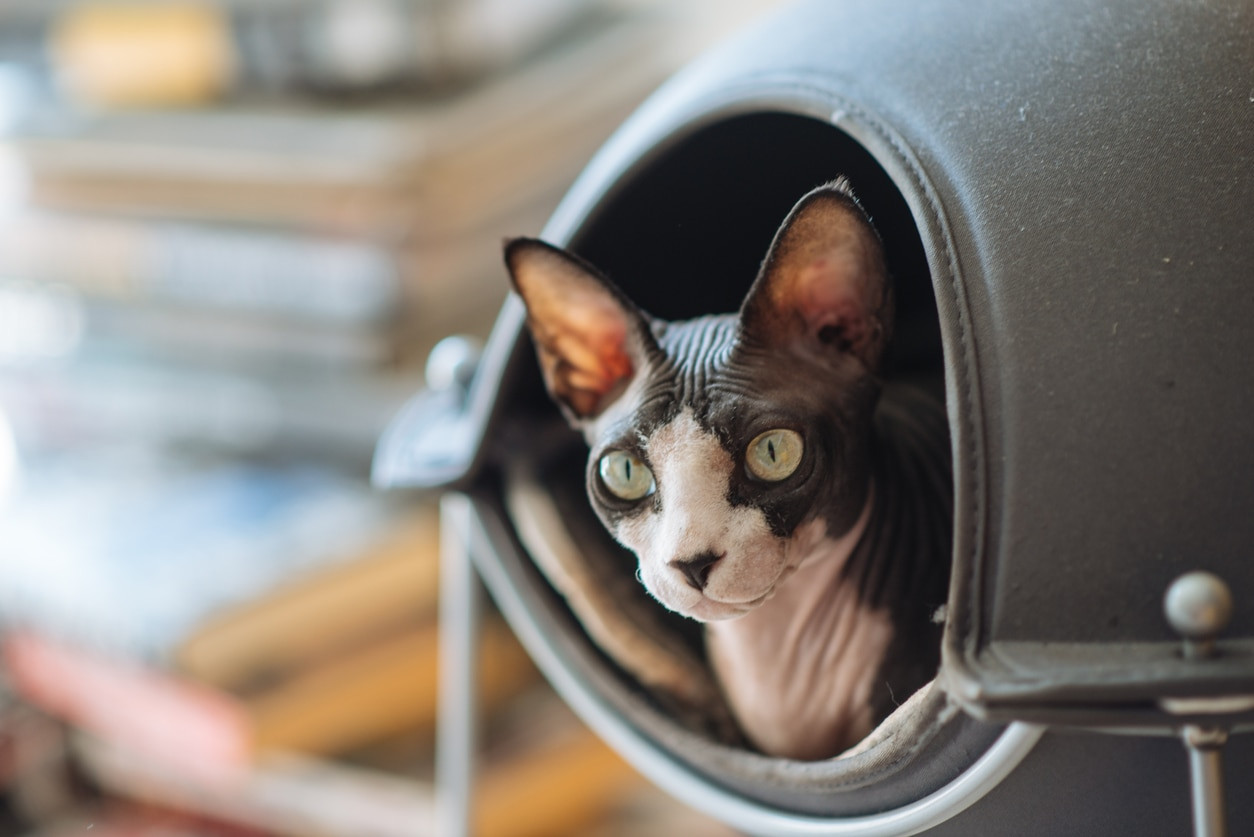 Intriguing black and pink Sphynx cat gazes from a covered cat bed
Intriguing black and pink Sphynx cat gazes from a covered cat bed
Photo credit: iStock/Drazen_
Compared to other cat breeds, Sphynx cats stand out with their most distinctive hypoallergenic trait: their near hairlessness. Sphynx cats can range from completely hairless to having a light covering of soft downy fuzz. This lack of fur significantly reduces the amount of hair and dander, major allergy triggers, in the environment. Consequently, Sphynx cats are often well-tolerated by individuals with cat allergies, especially compared to fluffy cat breeds. However, their hairlessness does not equate to low maintenance. Sphynx cats require regular bathing to remove oil buildup on their skin, as they lack fur to absorb these oils. Their unique appearance and playful, affectionate personalities make them captivating and devoted pets for those prepared to meet their specific care needs.
6. Devon Rex Cat
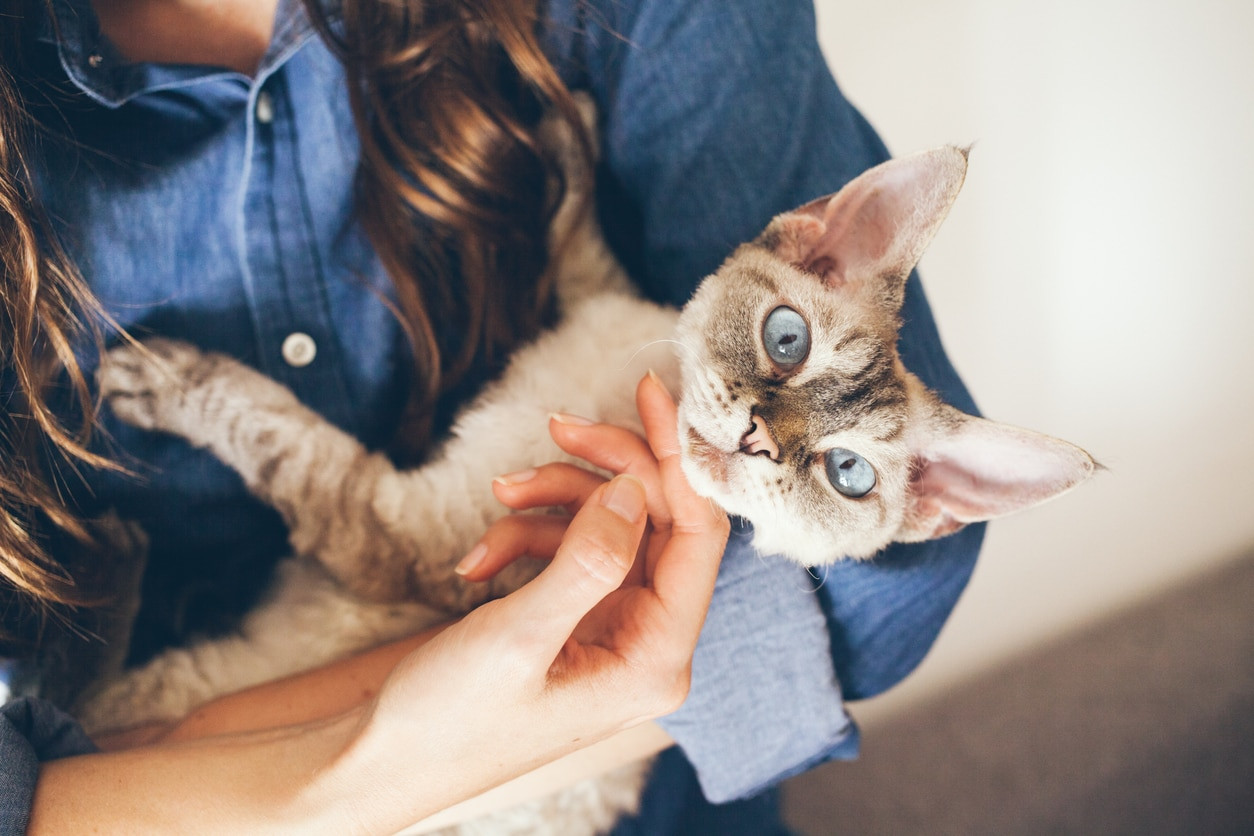 Woman lovingly cradles a slender Devon Rex cat like a baby
Woman lovingly cradles a slender Devon Rex cat like a baby
Photo credit: iStock/insonnia
With their distinctive short, wavy, and incredibly soft coat, the Devon Rex is another excellent hypoallergenic cat breed option. Their unique coat texture, often described as suede-like, is a result of a genetic mutation. Devon Rex cats are not only allergy-friendly but also known for their affectionate and intelligent nature. They are playful and enjoy interacting with their families, often described as being “dog-like” in their devotion and desire for companionship. However, Devon Rex cats are social creatures who thrive on attention and can become lonely if left alone for extended periods. Therefore, if you are frequently away from home, the Devon Rex might not be the best breed choice unless they have another companion or receive ample attention when you are home.
7. Cornish Rex Cat
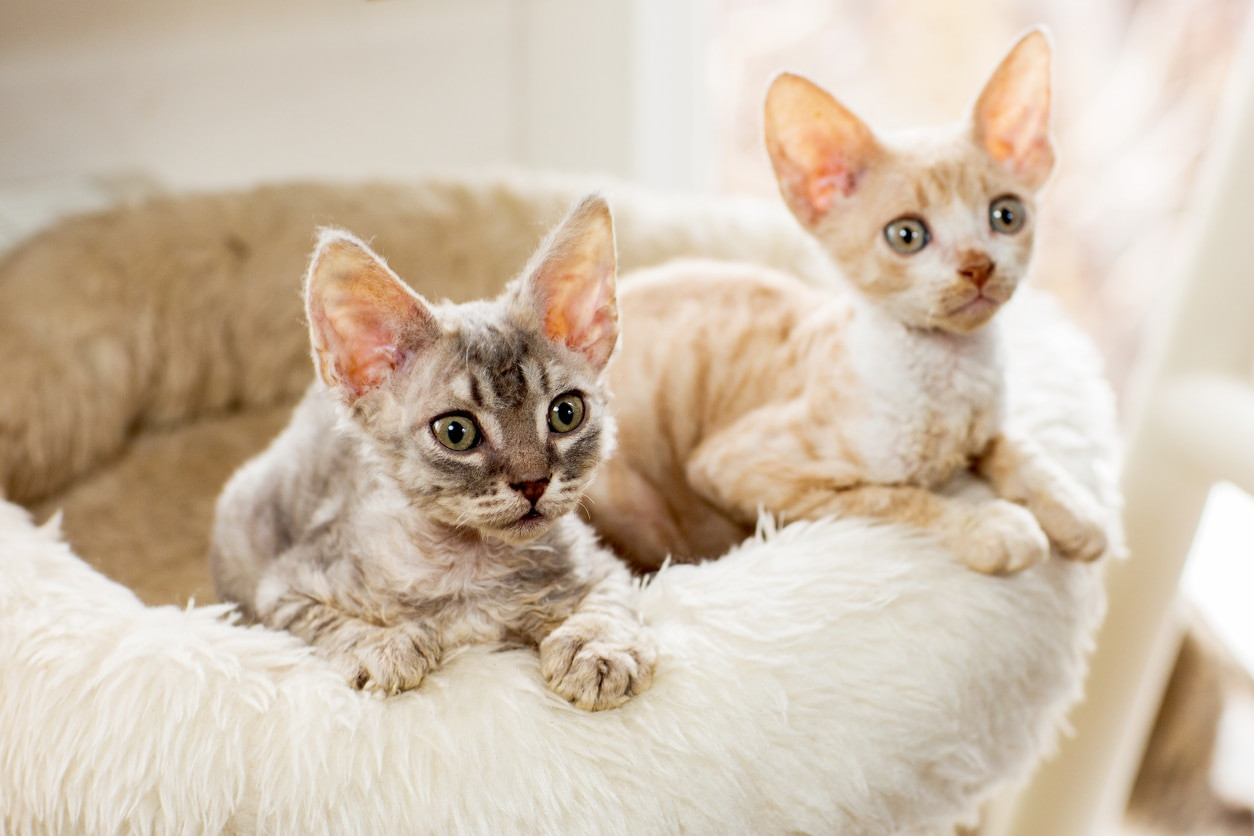 Two adorable Cornish Rex kittens snuggle in a cozy cat bed
Two adorable Cornish Rex kittens snuggle in a cozy cat bed
Photo credit: iStock/Sicha69
Similar to the Devon Rex, the Cornish Rex cat boasts a curly, soft coat, making them another popular hypoallergenic breed. Their coat is even shorter and finer than the Devon Rex, lying close to the body, which contributes to reduced shedding and allergen dispersal. Cornish Rex cats are renowned for their affectionate and people-oriented personalities. They are often described as being kitten-like throughout their lives, maintaining a playful and energetic demeanor. They are known to be excellent with children and generally get along well with other pets, making them wonderful family companions. Cornish Rex cats are high-energy and require plenty of playtime and exercise to stay happy and healthy. While their grooming needs are minimal due to their short coat, regular interaction and play are crucial for their well-being. If you seek a lively, affectionate, and relatively low-allergen cat, the Cornish Rex is an excellent choice.
8. Javanese Cat
 Elegant gray Javanese cat mother attentively grooms her kittens
Elegant gray Javanese cat mother attentively grooms her kittens
Photo credit: Adobe Stock/Heidi Bollich
Javanese cats are another hypoallergenic cat breed that defies expectations with their longer coat. Despite having a silky, medium-length coat, Javanese cats are considered low-shedding and produce fewer allergens. However, their longer coat does require consistent grooming to prevent matting and tangles, even though they don’t shed much. Javanese cats are known for being highly intelligent, playful, and vocal. They are very people-oriented and thrive on interaction, often following their owners around the house and participating in activities. These social kitties can be quite demanding of attention, so they may not be the best fit for those seeking a very independent cat. If you appreciate a communicative, engaging feline companion and are willing to dedicate time to grooming, the Javanese cat can be a rewarding, allergy-friendly pet.
9. Balinese Cat
 Graceful long-haired Balinese cat snuggles with a woman
Graceful long-haired Balinese cat snuggles with a woman
Photo credit: Adobe Stock/New Africa
The elegant Balinese cat is essentially a long-haired version of the Siamese, sharing many of the same traits, including being considered hypoallergenic. Despite their flowing, silky coat, Balinese cats produce lower levels of the Fel d 1 protein, making them suitable for many allergy sufferers. Like Siamese, Balinese cats are affectionate, intelligent, and vocal. They are known to be very people-oriented and enjoy being part of family life, making them great pets for households with children. Balinese cats are also intelligent and trainable, often enjoying learning tricks and engaging in interactive play. While their longer coat requires regular brushing to prevent mats and tangles, the effort is often worthwhile for those seeking a beautiful, affectionate, and relatively allergy-friendly long-haired cat breed.
10. Oriental Shorthair Cat
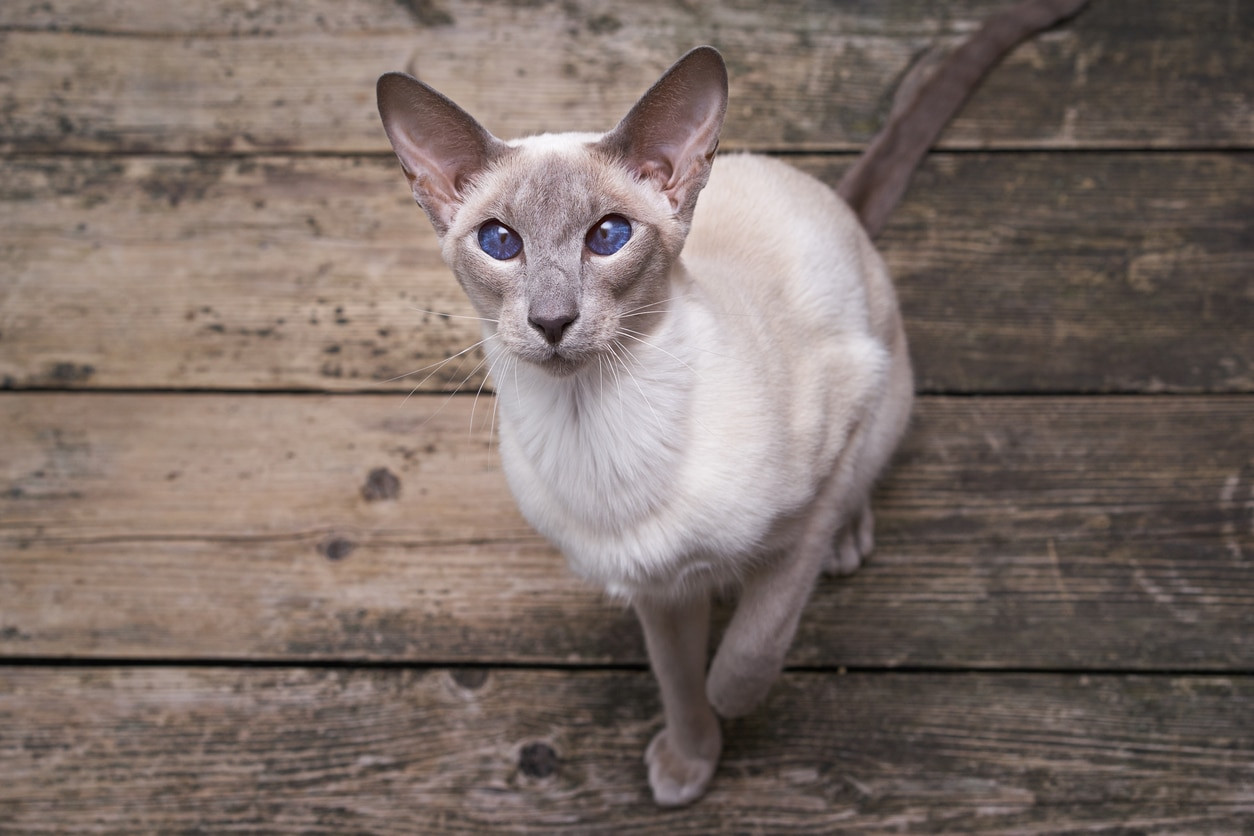 Alert gray and white Oriental Shorthair cat attentively looks up at the camera
Alert gray and white Oriental Shorthair cat attentively looks up at the camera
Photo credit: iStock/Leschenko
Oriental Shorthair cats are known for their striking, slender appearance and large, expressive ears. As their name suggests, they have a short, fine coat that requires minimal grooming, contributing to their hypoallergenic reputation. Oriental Shorthairs are not only good for allergy sufferers but also bring a delightful combination of intelligence and playfulness into a home. They are highly active and curious cats who love to explore and interact with their environment. Oriental Shorthairs are known to be very social and enjoy being around people, forming strong bonds with their families. They are also known for their distinctive vocalizations, often described as a unique “honking” meow. If you are seeking an intelligent, active, and low-maintenance hypoallergenic cat breed, the Oriental Shorthair is an excellent choice.
11. Burmese Cat
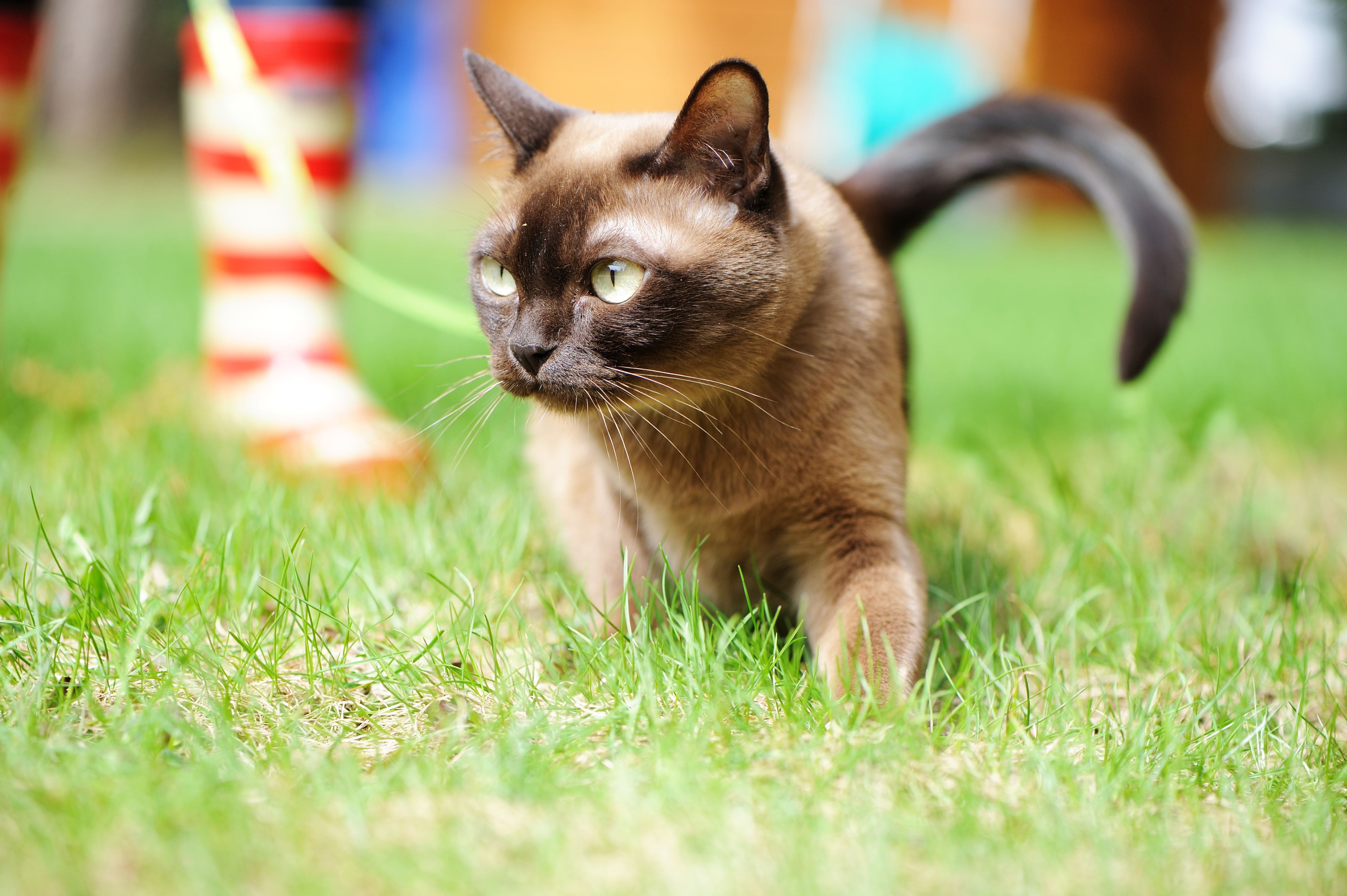 Agile Burmese cat confidently walks on a leash and harness outdoors
Agile Burmese cat confidently walks on a leash and harness outdoors
Photo credit: Adobe Stock/Alinute
The sleek and graceful Burmese cat is another short-haired hypoallergenic breed. Their short, satin-like coat requires very little grooming and sheds minimally, making them a good option for allergy-conscious individuals. Burmese cats are known for their affectionate and people-loving personalities. They are highly intelligent and active cats who enjoy playtime and interaction. Burmese cats are often described as being “dog-like” in their loyalty and desire to be with their families. They are also quite vocal and enjoy “conversing” with their owners. If you are looking for a devoted, intelligent, and relatively low-maintenance hypoallergenic cat, the Burmese is a wonderful breed to consider.
12. Tonkinese Cat
 Champagne-colored Tonkinese cat sits on the floor, looking directly at the camera
Champagne-colored Tonkinese cat sits on the floor, looking directly at the camera
Photo credit: Adobe Stock/Steve Mann
Tonkinese cats are a delightful blend of Siamese and Burmese traits, inheriting the best of both breeds, including hypoallergenic qualities. While they possess a short coat, Tonkinese cats are low-shedding and produce fewer allergens, making them potentially suitable for some individuals with allergies. Like their parent breeds, Tonkinese cats are known for being lively, energetic, and highly social. They crave interaction and playtime, thriving on being involved in family activities. Tonkinese cats are also intelligent and vocal, often engaging in conversations with their owners. If you are seeking an active, affectionate, and relatively allergy-friendly cat breed, the Tonkinese offers a charming and engaging companion.
Tips for Adopting a Hypoallergenic Cat
Choosing a hypoallergenic breed is a great first step, but there are additional measures you can take to minimize allergy symptoms when living with a cat.
Conduct Thorough Research
If you’re serious about adopting a “hypoallergenic” cat, in-depth research is essential. Learning about different breeds and their specific traits will help you find the best match for your lifestyle and allergy concerns. Crucially, spend time with the specific cat breed you’re considering before bringing them home. Direct interaction is the most reliable way to assess your allergic reaction to that particular breed and individual cat.
Consult with an Allergy Specialist
Before welcoming a cat into your home, consulting with an allergy specialist is a proactive step. An allergist can help determine the severity of your cat allergies and recommend strategies for managing symptoms. They may also suggest allergy medications or other treatments that can make living with a cat more comfortable.
Maintain a Clean Home Environment
Regular cleaning is crucial in managing cat allergies. Even hypoallergenic cats produce some allergens. Regular cats shed hair and dander that can accumulate on surfaces throughout your home. Frequent vacuuming, dusting, and washing bedding can significantly reduce allergen levels. While hypoallergenic cats shed less and produce less dander, maintaining a clean home remains important to minimize any potential allergy symptoms.
Discuss Diet with Your Veterinarian
In addition to breed selection, innovative solutions like specialized cat food can further reduce allergens. Purina® Pro Plan® LIVECLEAR is a cat food formulated to significantly reduce the major Fel d 1 allergen in cat hair, dander, and saliva. Consulting with your veterinarian can help determine if this type of diet would be beneficial for your cat and allergy management strategy.
FAQs About Low-Shedding Cats
Are there truly non-shedding cats?
Completely hairless cats, such as the Sphynx, are often considered non-shedding cats in terms of fur. However, even hairless breeds produce allergens in their skin, saliva, and urine. While they don’t shed fur, they still require regular bathing to manage skin oils, and they are not entirely allergen-free.
Can a cat be 100% hypoallergenic?
No, the concept of a 100% hypoallergenic cat is a myth. All cats produce allergens to varying degrees. Even breeds considered hypoallergenic still produce allergens, albeit typically at lower levels than some other breeds. Managing cat allergies involves a combination of breed selection, environmental control, and potentially medical management, rather than relying on the existence of a completely allergen-free cat.
WRITTEN BY
Nicole Zittritsch, LVT, BSc, MPH
Veterinarian Technician

